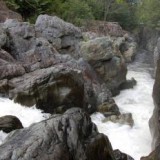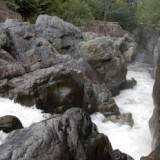In the second installment of a two-part series examining the failed private power model in BC, geologist and concerned British Columbian George Gibson focuses on the proposal to dam and divert the Kokish River as a prime example of the flawed BC Liberal energy policy.
———————————–
An introduction and promotion from the proponents of the Kokish Project – benefits of this project:
Security of power supply: In winter, North Island communities not only utilize more electricity, they also experience a high incidence of power outages. Unlike many BC river systems, where peak flows occur during spring freshet, flows on the Kokish River are at their highest in late fall and winter. These high flows will make it possible for the Project to reliably generate enough power to supply the entire North Island.
Really?…That would be a neat trick. Here are some operational realities courtesy of Environment Canada and BC Hydro:
BC Hydro reports that “cold weather equals peak electricity demand” and makes specific reference to a period of sustained cold temperatures starting November 22, 2010 which placed an additional load of almost 2,000 MW on the system. A review of the Water Survey of Canada historic hydrometric data for the Tsitika River (the basis for a synthetic flow model for the Kokish) shows that this project would have been off line for the entire duration of this cold snap. Furthermore, a review of a less severe cold snap from January 15 – 17, 1970 using historical hydrometric data directly from the Kokish River shows that only a total flow of 4.5 m3/s would have been available. This facility requires a minimum flow of 21 m3/s, over and above minimum in-stream ecosystem requirements, for full 45 MW capacity output. Once again, this facility would have been either off line or at severely restricted capacity.
This blatant collusion is further propagated in a fact sheet example provided by the Clean Energy Association of BC promoting the urgency for IPP development. Colder than normal temperatures between January and April 2008 combined with unscheduled unit outages and other operational constraints created short term energy shortfalls that cumulatively required the import of 2,300 GWh. The Clean Energy BC Fact Sheet on Run-of-River explicitly promotes this technology as “providing a continuous source of clean, green renewable energy with minimal environmental impact.”
Firstly, BC Hydro is not in the business of importing expensive on-peak market electricity unless these imports are intended to cover short term capacity issues. The demand driver in this case was cold weather. How much capacity relief did run-of-river power producers contribute during these conditions? Once again, the hydrometric data for the Tsitika River, over this period, shows meager flows during every single cold snap. The Kokish facility would not have been available to provide BC Hydro with any effective capacity support during these short term capacity shortfalls. Much of the imported 2,300 GWh (about 800 MW of additional average daily capacity over the four month period) would still have had to come from some other non-hydro source.
Even more ironic, is that the only non-hydro source of clean energy capable of providing this level of capacity support, is available right now from the Northwest Power Pool. Would it not make more sense for BC Hydro’s marketers to spend their time securing firm energy purchase agreements from the wind power producers located right on our door step?
Secondly, run-of-river IPPs are far from immune to unscheduled unit outages. We will now consider a major vulnerability unique to this type of infrastructure.
Seismic hazard risk and run-of-river infrastructure: Electricity self-reliance and public safety will be the first casualties.
The energy security mandates of BC’s Clean Energy Act, including private sector promotions of run-of-river development on Vancouver Island and along the coastal mainland, quite literally, have the greatest potential for catastrophic failure. This is for two reasons:
- Proximity to major geologically active fault structures that have a 100% probability of generating a destructive earthquake.
- Inherent seismic vulnerabilities in run-of-river infrastructure that precludes cost-effective hardening measures.
Seismic hazards in BC are most severe along coastal regions and include two major offshore threats: “Canada’s equivalent of the San Andreas fault”, running from northern Vancouver Island to the Queen Charlotte Islands, and the Cascadia Subduction Zone, extending from northern Vancouver Island to northern California. The Cascadia Subduction Zone has been the source of massive magnitude 9+ earthquakes at intervals ranging between 300-800 years. The last one was on January 26, 1700….do the math! An even greater threat is posed by strain build up between these intervals that produces, on average, one onshore event per decade. These events are typically smaller in magnitude but occur much closer to built-up areas, as in the June 23, 1946 magnitude 7.3 earthquake centered beneath mid-Vancouver Island.
Infrastructure vulnerabilities to earthquake damage have now become a major consideration for populations in high hazard locations. Experience has repeatedly demonstrated that one of the most vulnerable components of critical “lifeline” infrastructure are water supply systems. Equally vulnerable are wastewater or sewage systems. Water pipeline infrastructure is vulnerable because it is typically buried just below the surface where destructive surface wave energy is concentrated. Furthermore, analysis from the February 27, 2010 magnitude 8.8 offshore earthquake in Chile demonstrated that water pipelines were particularly prone to rupture when buried in loosely consolidated soils. Specifically it was observed that “areas within 200’ (or so) of river banks often suffered lateral spreads and settlements”. A partial tally of the damage to water supply pipelines in the Concepcion area alone included 72 breaks or leaks to large diameter welded steel pipes and over 3000 breaks in water mains and service laterals. One year later, the repairs were ongoing. In addition to this, wastewater systems suffered heavily, including damage to large diameter interceptor pipes and small diameter collector pipes.
None of the above findings bode well for a power generating facility dependent on a long water pipeline (penstock) to deliver water from an intake weir to a powerhouse. Specific features of the Kokish run-of-river project are supplied by the proponent:
Minimal requirement for new infrastructure: The Project’s proximity to existing roads and transmission lines will minimize requirements for new infrastructure, which will in turn reduce environmental impacts and clearing requirements, and help reduce project costs. The low level weir and intake will be located within 100 m of the Kokish Main Road on the east side of the Kokish River. The 9 km buried penstock will run parallel to the Kokish Main Road for about 80% of its length, and the powerhouse and switchyard will be situated on land that is immediately adjacent to the Telegraph Cove Road.
The Kokish run-of-river project is located only 150 km from the Nootka Fault, one of BC’s most seismically active regions. This is located essentially at the confluence of the “San Andreas of the north” and the Cascadia Subduction Zone. This is also very close to the location of BC’s most recent wake up call that rattled Vancouver Island last year.
In light of the information presented above, it should be obvious that not only is this project susceptible to catastrophic earthquake damage, it poses the additional risk of damaging or interfering with access to critical road and highway infrastructure. This is no trivial matter: A rupture anywhere along the 9km length of the Kokish facility’s penstock could cause the uncontrolled release of nearly 6,000 gallons of water per secon Damage at or near the powerhouse would be compounded by very high water pressure: 2,140 KPa or about 300 psi.
Where’s the value?
BC Hydro will be obliged to purchase 180 GWh/year from the Kokish run-of-river facility. This amounts to approximately 1/3 of 1% of BC Hydro’s total integrated system requirements and will contribute 0 MW of capacity support during peak system loads. This energy will cost BC Hydro approximately $18 million dollars/year, nearly the same amount of capital dedicated to vegetation management for Hydro’s entire system. Today, BC Hydro could purchase approximately 580 GWh of on-peak (high demand conditions) market electricity or in excess of 1000 GWh of off-peak (low demand conditions) market electricity for the same $18 million.
Proponents of the $200 million Kokish Project list additional benefits as the full-time employment of approximately 70 people over the two year construction phase of the project. Like all other run-of-river facilities, the subsequent operation of this facility would be automated, requiring no further significant employment opportunities. The argument that this is an effective job creation strategy is a slap in the face to the ecotourism businesses established in the area. A single whale watching operation based in Telegraph Cove has contributed at least this number of man hours of employment with many more to come. Furthermore, their customers contribute to a cascade of economic spin-offs for the community. There is no Clean Energy Act directive to support sustainable family businesses that promote the importance of environmental stewardship.
LNG Exports to Asia to be powered by new clean energy projects: A complete loss of integrity and credibility for Government and Clean Energy Producers
This idea is a serious contender for the “Darwin Awards” as the most counterproductive initiative ever conceived. A brief review of one inconvenient reality that both Government and clean energy producers have chosen to ignore: The concept of thermal efficiency. This is the single most effective variable available to combat GHG emissions. Thermal efficiency is a measure of how efficient or wasteful a fuel burning process is. A few examples:
- typical automotive engine (gasoline) ~ 25%
- coal-fired power plant ~ 45%
- modern combined cycle natural gas power plant ~ 60%
- high efficiency natural gas appliance (furnace or water heater) ~ 98%
This demonstrates how extraordinarily wasteful we are with our fossil fuel use. Any use other than for the purpose of heating contributes significant and unnecessarily GHG emissions. It is especially important to note that the use of electricity from a natural gas power facility for heating purposes reflects poor management of this resource.
The LNG proposal promoted by Premier Christy Clark is predicated on the use of natural gas to displace coal-fired power plants. In fact, by supporting this practice, the carbon footprint of BC’s natural gas will be increased dramatically. Pipeline transportation to the coast, conversion to LNG, and shipping to Asian markets all compound GHG emissions either directly or indirectly. It is important to remember, the construction process for the required infrastructure, including building new clean energy facilities, all produce significant GHGs. Furthermore, BC has no control over how this resource will be used at the other end. In a complete twist of irony, China uses a huge amount of natural gas for feedstock in the production of ammonia for petrochemical fertilizer. This is due, in part, to the vast tracts of fertile flood plains that have been sacrificed for massive hydropower projects. The use of natural gas for the production of ammonia has been specifically identified as having one of the highest intensities of GHG emissions.
DSM (Demand Side Management): The only practical, affordable, and effective option
The Smart Meter Program is a specific directive of the Clean Energy Act. It mandates that BC Hydro communicates a very simple message to its customers, in the most expensive way possible! It will cost BC Hydro close to $1 billion to say “you’re screwed” to those customers unfortunate enough to rely on electricity to heat their homes. We have previously demonstrated a massive potential reduction in the supply gap that would be possible by getting customers to fuel switch their heating demands from electricity to natural gas. This is already a “no-brainer” by today’s comparative energy costs. Pending future increases in electricity costs will only serve to force the issue. In fact, only about 20% of a typical BC household’s annual energy demands (25 MWh) require electricity: appliances and electronics(15%), and lighting(5%). The remaining 80% is split between space heating(60%)and water heating(20%). Therefore up to 80% of household energy use could be supplied by natural gas.
This option for fuel switching is a significant advantage for BC. A winter peaking energy profile allows for efficient substitution of domestic energy resources. In contrast, large export markets such as California, have summer peaking energy profiles where electricity-dependent cooling demands are the main drivers of energy consumption. The total annual energy requirements for BC’s residential sector are about 45,000 GWh. However, only about 9,000 GWh are dependent on electricity. This presents an opportunity for BC Hydro to once again become a highly profitable clean energy exporter using existing capacity from its heritage assets. These exports would be displacing the much less efficient use of natural gas for producing electricity to power California’s air conditioners.
The most efficient use of BC’s natural gas is for domestic energy requirements in high efficiency furnaces and water heaters. Natural gas committed to household energy use could easily eliminate any anticipated electricity supply gap for years to come. Furthermore, it would eliminate any dependence on private power producers and put a stop to the completely unnecessary sacrifice of our rivers and streams. Perhaps more importantly, BC would be able to ensure the most effective management of GHG emissions from this resource.
The race for BC to become a world leader in new clean energy production was over long ago, when Government and the private power sector blew their wager on run-of-river technology. A failure from all influences on this particularly ill-suited initiative for BC has been offset only by stunning successes in the wind power industry. It defies all logic that BC Hydro should not be able to take full advantage of this already established massive new resource and optimize natural operational synergies with other partners in the Northwest Power pool.
The only things standing between efficient management of BC’s GHG emissions, affordable electricity, and a highly profitable public utility are the Clean Energy Act and the boneheads behind it.
Lessons learned
A fitting conclusion is provided by David Freeman, appointed chair of The California Power Authority during the California Electricity Crisis. This submission was made to the Senate Subcommittee on Consumer Affairs, Foreign Commerce and Tourism, on May 15, 2002:
There is one fundamental lesson we must learn from this experience: electricity is really different from everything else. It cannot be stored, it cannot be seen, and we cannot do without it, which makes opportunities to take advantage of a deregulated market endless. It is a public good that must be protected from private abuse. If Murphy’s Law were written for a market approach to electricity, then the law would state ‘any system that can be gamed, will be gamed, and at the worst possible time.’ And a market approach for electricity is inherently gameable. Never again can we allow private interests to create artificial or even real shortages and to be in control.
George Gibson is a retired geologist from Courtenay, BC , who applies his passion for science and the environment to wilderness preservation, and the promotion of environmental stewardship through ecotourism.





